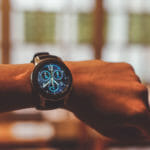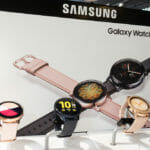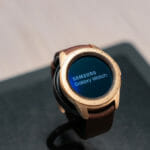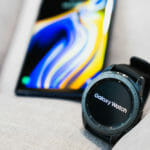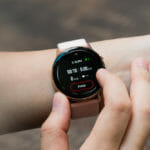If you’re thinking of buying a new smartwatch, you have probably considered the new Samsung Galaxy Watch 4 and Galaxy Watch 4 Classic models.
These smartwatches are not only stylish but are loaded with tons of features to keep you preoccupied for days. Moreover, they are super comfortable and lightweight on the wrist.
Both of these smartwatches are available in two sizes (Galaxywatch 4 is 44mm and 40mm whereas the Galaxy 4 Classic is 42mm and 46mm) and you can choose either Bluetooth/WiFi or LTE models.
The Galaxy Watch 4 is more compact and boasts a sporty design while the Classic has a more traditional appearance.
Both watches run on Wear OS which has been absent from Samsung’s designs for over 8 years. Both are powered by a brand new 5nm Exynos W920 chip and come with a 16GB storage capacity. They also come equipped with a body composition measurement feature.
With so much to like about both watches, it can be difficult to decide which one is best for you. One decision that many find hard to make is whether to choose between the Galaxy 4 Watch Bluetooth version or the LTE model. That is why we are here to help.
In today’s article, we will be comparing the new Galaxy Watch 4 Bluetooth and LTE models so you can understand the differences. Therefore, you can proceed and make an educated decision on which one is best for your needs.
Samsung Galaxy Watch 4: Bluetooth Versus LTE
Upon first inspection, there are no significant differences between the 44mm and 40mm Samsung Galaxy Watch 4 models. Of course, the main differences are size, price, and battery life.
When we study the Bluetooth and LTE versions, we find that both possess the same features. However, the LTE is more of a standalone smartwatch and offers cellular capabilities that Bluetooth doesn’t provide.
Both smartwatches run on Wear OS 3 and are powered by a 5nm W920. Samsung even claims that this chip provides a 20% increase in the watch’s CUP performance as well as 10x an increase in their GPU performances.
The storage capacity of both smartwatches has increased to 16GB with body composition being added as a useful feature as well as a host of health and fitness tracking features.
We will begin by looking at the comparisons of both Samsung Galaxy Watch 4 models so you can see if one smartwatch has the features you need. For the sake of this comparison, we will be looking at the 44mm Galaxy Watch 4.

Comparison
Samsung galaxy Watch 4 (44mm) (LTE)
Price: $279
Type: Fitness/Classic/Standalone
Gender: Unisex
Predecessor: Samsung Galaxy Watch Active 2
Versions: Bluetooth/WiFi, LTE
Shape: Circular
Dimensions: 44.4 x 43.3 x 9.8 mm
Weight: 30g
Strap size: 22 mm
Color: Black, Silver, Green
Strap material: Hybrid leather, Fluoroelastomer
Case material: Armor aluminum
Bezel material: Armor aluminum
Water resistance: Yes
Swim-proof: Yes
Display size: 1.4 inches
Display resolution: 450 x 450
Display Type: Full Color, Super Amoled
Pixels: 454.5 PPI
Input type: Touchscreen, 2 physical buttons, a physical bezel that rotates
Custom Watch face: Yes
Bluetooth: Yes (Bluetooth v5.0
Bluetooth calling: Yes
WiFi: Yes (Wi-Fi 802.11 a/b/g/n/ac
NFC: Yes
GPS: Yes (A-GPS/GLONASS/Beidou/Galileo
RAM: 1.5 GB
ROM: 16GB
Sim type: e-SIM
Email notification: Yes
SMS notification: Yes
Calls notification: Yes
Event reminders: Yes
Audio: mp3/mp4
Microphone: Yes
Bluetooth music: Yes
Loudspeaker: Yes
Microphone: Yes
Camera: No
Radio: No
Accelerometer sensor: Yes
Barometer: Yes
Altimeter sensor: Yes
Compass: Yes
Ambient light: Yes
Barometer: Yes
Gyroscope: Yes
ECG: Yes
HRM: Yes
Pulse oximeter (SPO2): Yes
Thermometer: No
BIA sensor: Yes
Blood oxygen: Yes
Blood pressure: Yes
Heart rate: Yes
Sleep tracker: Yes
Steps: Yes
Distance: Yes
Calories: Yes
VO2 Max: Yes
ECG tracking: Yes
Menstrual cycle: No
Stress: Yes
Fall detection: Yes
On-screen workout: Yes
Sport modes: 90
Battery Type: Li-ion non-removable battery
Battery life: Up to 2 days
Battery capacity: 361mAh
Charging time: 1-2 hours
Charging: Charging dock, WPC based wireless charging
Solar power: No
Operating system: Wear OS/Tizen
CPU: 1.18GHz Dual-core (Corex-A55)
GPU: MaliTM-G68 MP2
Chipset: Exynos W920
Voice command: Yes (Google Assistant)
Compatibility: Android 6.0+, RAM 1.5GB+
Companion app: Samsung Health App
Payment: Samsung Pay
Interchangeable strap: Yes (22mm)
Find my phone: Yes
Box contents: Manual, charger, straps, Samsung Galaxy Watch 4 (see also 'Is The Galaxy Watch 4 Waterproof?')
Samsung Galaxy Watch 4 (44mm)
Price: $229
Type: Fitness/Sport
Gender: Unisex
Predecessor: Samsung Galaxy Watch Active 2
Versions: Bluetooth/WiFi, LTE
Shape: Circular
Dimensions: 44.4 x 43.3 x 9.8 mm
Weight: 30g
Strap size: 22 mm
Color: Black, Silver, Green
Strap material: Hybrid leather, Fluoroelastomer
Case material: Armor aluminum
Bezel material: Armor aluminum
Water resistance: Yes
Swim-proof: Yes
Display size: 1.4 inches
Display resolution: 450 x 450
Display Type: Full Color, Super Amoled
Pixels: 454.5 PPI
Input type: Touchscreen, 2 physical buttons, a physical bezel that rotates
Custom Watch face: Yes
Bluetooth: Yes (Bluetooth v5.0
Bluetooth calling: Yes
WiFi: Yes (Wi-Fi 802.11 a/b/g/n/ac
NFC: Yes
GPS: Yes (A-GPS/GLONASS/Beidou/Galileo
RAM: 1.5 GB
ROM: 16GB
Sim type: None
Email notification: Yes
SMS notification: Yes
Calls notification: Yes
Event reminders: Yes
Audio: mp3/mp4
Microphone: Yes
Bluetooth music: Yes
Loudspeaker: Yes
Microphone: Yes
Camera: No
Radio: No
Accelerometer sensor: Yes
Barometer: Yes
Altimeter sensor: Yes
Compass: Yes
Ambient light: Yes
Barometer: Yes
Gyroscope: Yes
ECG: Yes
HRM: Yes
Pulse oximeter (SPO2): Yes
Thermometer: No
BIA sensor: Yes
Blood oxygen: Yes
Blood pressure: Yes
Heart rate: Yes
Sleep tracker: Yes
Steps: Yes
Distance: Yes
Calories: Yes
VO2 Max: Yes
ECG tracking: Yes
Menstrual cycle: No
Stress: Yes
Fall detection: Yes
On-screen workout: Yes
Sport modes: 90
Battery Type: Li-ion non-removable battery
Battery life: Up to 2 days
Battery capacity: 361mAh
Charging time: 1-2 hours
Charging: Charging dock, WPC based wireless charging
Solar power: No
Operating system: Wear OS/Tizen
CPU: 1.18GHz Dual-core (Corex-A55)
GPU: MaliTM-G68 MP2
Chipset: Exynos W920
Voice command: Yes (Google Assistant)
Compatibility: Android 6.0+, RAM 1.5GB+
Companion app: Samsung Health App
Payment: Samsung Pay
Interchangeable strap: Yes (22mm)
Find my phone: Yes
Box contents: Manual, charger, straps, Samsung Galaxy Watch 4
Bluetooth Versus LTE: Which Is Cheaper?
The LTE Samsung Galaxy Watch 4 model has a higher price tag due to its standalone properties and capabilities. As you can imagine, the 40mm Bluetooth model costs a little less ($30) than the 44mm Bluetooth smartwatch.
The same applies to the 40mm LTE and the 44mm LTE versions. However, the LTE model is a little more expensive.
The LTE smartwatch features an eSIM that allows you to make and receive calls and messages. And, this is entirely independent of your smartphone.
This eSIM is the main difference between the LTE and Bluetooth models as the Bluetooth smartphone does not feature this sim card.
The eSIM enables the LTE model to complete standalone capabilities such as making and receiving calls. It can also receive messages and allows you to install different apps directly onto your watch without using your smartphone.
Yes, you can do all of this with a Bluetooth model but your smartphone must be nearby for you to make calls and receive messages. The same applies to receiving apps.
The LTE model simply gives you additional freedom in your user experience. If you want a smartwatch that allows you to send and receive calls as well as receive messages without taking your phone everywhere with you, then we fully recommend the Samsung Galaxy Watch 4 LTE model.
What Carriers Are Supported?
While the LTE model of the Galaxy 4 Watch sports some additional features, you must ensure that it can work in your region.
To confirm whether the smartwatch is the right model for your region, you can visit the Samsung Galaxy Watch 4 Carrier List to find out for sure.
All-in-all, there are a total of four models available across the world. These are:
- The 44mm: SM-875U, SM-875F, SM-875N, and SM-895
- THE 40mm: SM-865U, SM-865F, and SM-865N
In the U.S, the supported models are the SM-875U and the SM-865U. These are supported with T-Mobile, AT&T, Verizon, and US cellular.
You should also check with your network provider to see what plans are available for the Samsung Galaxy Watch 4 LTE model.
Battery Life
Both the Bluetooth and LTE may have the same battery capacity but the Bluetooth model actually has a longer battery life when the LTE is switched-on.
Aside from this, the battery life is the same. The 44mm models can run for up to 2 days while the 40mm smartwatch can run for about a day.
Both smartwatches also sport battery saver modes that can help you prolong the battery life. If you want to save some battery life on the Galaxy Watch 4, you should try the following:
- Reduce the display brightness
- Turn off some app notifications
- Switch-off the “always-on” display
For LTE Galaxy watch 4 models, simply turn off LTE when your phone is close by and turn off its GPS when not in use.
Cellular Connectivity
Many people ask whether the Samsung Galaxy Watch 4 LTE model works without cellular connectivity. The short answer is, yes. You can use the LTE model just like the Bluetooth model. Simply go to settings in the menu and turn LTE off if you wish to use the device as a Bluetooth model.
As we discussed earlier, the key difference between the two is the presence of an eSIM in the LTE model. But, as we stated, you can choose to use it as a Bluetooth model if you desired.
Samsung Galaxy Watch 4 Features
Both Galaxy watch 4 models feature the same armor aluminum cases. And both are paired with hybrid leather or fluoroelastomer straps. However, you can swap these straps with standard 20mm straps for the 40mm model or 22mm straps with the 44mm device.
Both models also feature an AMOLED display. This is as well as a touchscreen, two physical buttons, and a digital rotating bezel. These all offer effortless navigation of the smartwatch. It’s just up to you which one you prefer to use most frequently.
Both the LTE and Bluetooth models are also equipped with a ton of activity tracking features. You can track how many steps you do a day, the floors you have climbed, your distance covered, your heart rate, your ECG, blood pressure, SpO2 blood oxygen levels, sleep, and blood pressure.
And, there is the advent of a body composition measurement tool. This allows you to measure your body fat mass index and lean (fat-free) mass.
Each model also offers over 90 preloaded sport modes with each one including a built-in GPS for tracking outdoor activity.
RUNNER UP
With so many features, it can become quite confusing to take all the information in. Let’s make it a bit easier by looking at the pros and cons of the Samsung Galaxy Watch 4 (44mm) model:
Pros
- Stylish
- Lightweight
- Compact
- Comfortable
- Premium design
- Comprehensive features for a fitness smartwatch
- Includes a built-in microphone and loudspeaker
- Sports 16GB of onboard music storage
- Durable and rugged certified MIL-STD-810G
- Included Wear OS that allows you to access more apps
- Boasts a physical rotating bezel for the easiest navigation possible
- Offers exceptional performance with Exynos W920 and 1.5GB RAM.
- LTW model is a standalone smartwatch
Of course, we need to look at some of the cons of this smartwatch for you to make an educated decision:
Cons
- A short battery life
- The ECG, BIA, and blood pressure tracking apps may not work with non-Samsung devices
- It is not compatible with iOS devices
Here’s a round-up of the stand out features with both models:
- A 1.4-inch always-on display powered by AMOLED.
- Navigation can be achieved via touchscreen support, two physical buttons, and a digital rotating bezel.
- Available in black, green, or silver.
- Cases are constructed from armor aluminum as well as the bezel.
- The straps are made of fluoroelastomer.
- Both are rated as 5ATM (50 meters) swim-proof models. Allows you to eject water from the loudspeaker after being immersed in water.
- The watch face is interchangeable. You can choose from preloaded watch faces or browse the app store for more.
- Durable and rugged with MIL-STD-810G-US military-grade rating for shock absorption.
- Both offer 16GB of storage capacity that allows you to store a great deal of music. You can even stream music from services such as Spotify if you want but we recommend connecting headphones for the best sound experience.
- Both are equipped with a microphone and a loudspeaker.
- Voice assistance is featured (Google Assistant and Bixby). These are powered by Samsung and allow you to use your voice to perform simple tasks.
- Can make on-the-go non-contactless payments via Samsung Pay. However, Google Pay is expected to be available in the near future.
- Can stay connected via email, SMS, and set personal reminders for important dates. You can also check the weather forecast, unlock your phone, enjoy music playback on your phone, use remote camera control, and receive notifications from third-party apps that are sent directly to your watch.
- The LTE model allows you to make and receive calls as well as receive messages without using your smartphone.
- Runs on the new Wear OS/Tizen operating system. This features Samsung’s One UI 3.0 interface that provides a better user experience. This also provides easier access to more apps.
- Built with 1.5GB RAM and a brand new 5nm W920 Exynos chip. According to Samsung, this helps the CPU run 20% faster and enables a 10x faster performance for the GPU.
- Fully compatible with Android 6.0 or higher and RAM 1.5GB above.
The Samsung Galaxy Watch 4 (44mm): Fitness Tracking Features
The 44mm model boasts many features to help you keep track of your activities throughout the day.
- The smartphone continuously tracks all of the basic apps such as calories, steps, distance, ad floors climbed
- Also tracks your sleep during four stages (light, deep, awake, and REM)
- Continuously tracks your heart rate and displays your average, maximum, and resting heart rate.
- Features an electrical heart sensor that enables you to track your EC for any possible irregular heart rhythms. It can also help detect any atrial fibrillations.
- You can measure your stress levels which, in turn, can help you manage your stress through guided breathing exercises.
- Monitors blood pressure. But, for the best results, you will need to calibrate the Galaxy watch 4 Classic with a traditional cuff. You will also need to install the Samsung health Monitor app for this feature to work correctly.
- Features Spo2 measurement that allows you to measure your blood oxygen levels.
- Includes 90 preset workout modes to choose from. Also has the ability to auto-detect and track seven of these apps.
- A superb feature is incidental fall detection. This will call a preset emergency contact if the Samsung Galaxy Watch 4 detects a hard fall (find out more about phone calls on Galaxy Watches here).
- Features an SOS emergency feature that allows you to set your emergency contacts to the watch. This will auto-call these contacts when you press the home button three times. This can also send messages to your preset emergency contact to inform them of your location.
- An app to remind you to wash your hands continuously for 20 seconds.
- Displays your VO2 max after strenuous activity outdoors and tracks your fitness level.
- Features Bioelectrical Impedance Analysis (BIA). This enables you to measure your body composition (fat mass and fat-free (lean) mass). This measures your body water, body fat, skeletal muscle mass, and your BMI.
Which Is Best For You? Samsung Galaxy Watch 4 LTE Versus Bluetooth
From reading our guide on the LTE and Bluetooth versions of the Samsung Galaxy Watch 4, it’s quite clear to see that the LTE offers more features than the Bluetooth model.
Overall, the LTE smartwatch is more comprehensive all round in that it allows you to make and receive calls and receive messages without using a smartphone. Of course, this comes with a higher price tag but the difference is not substantial.
Currently, the Galaxy Watch 4 Bluetooth model is the most popular amongst users. It is cheaper and offers most of the same features as the LTE model.
The key difference is that you will need to carry your phone with you if you wish to make and receive calls on the Bluetooth smartwatch.
It’s your personal preference at the end of the day. If you do not want to carry your smartphone everywhere, the LTE version is the right choice.
But, if this isn’t an issue, the Bluetooth has everything the LTE version has to offer. In general, it comes down to what you can afford.
If you can afford the extra cost of a Samsung Galaxy Watch 4 LTE model, then you will also get a data subscription under this price. Whichever you choose, you will end up with a top-quality smartwatch with more features than you could ever want.
- How to use a smartwatch for ECG readings: Because Your Wrist Knows More Than Your Ex - November 1, 2025
- How to use a fitness tracker for podcast listening: Steps, Strides, and Satisfying Stories - November 1, 2025
- Bluetooth Headphones Error Code 201 Fix: Why Your Music Suddenly Hates You and How to Make Up - October 31, 2025


